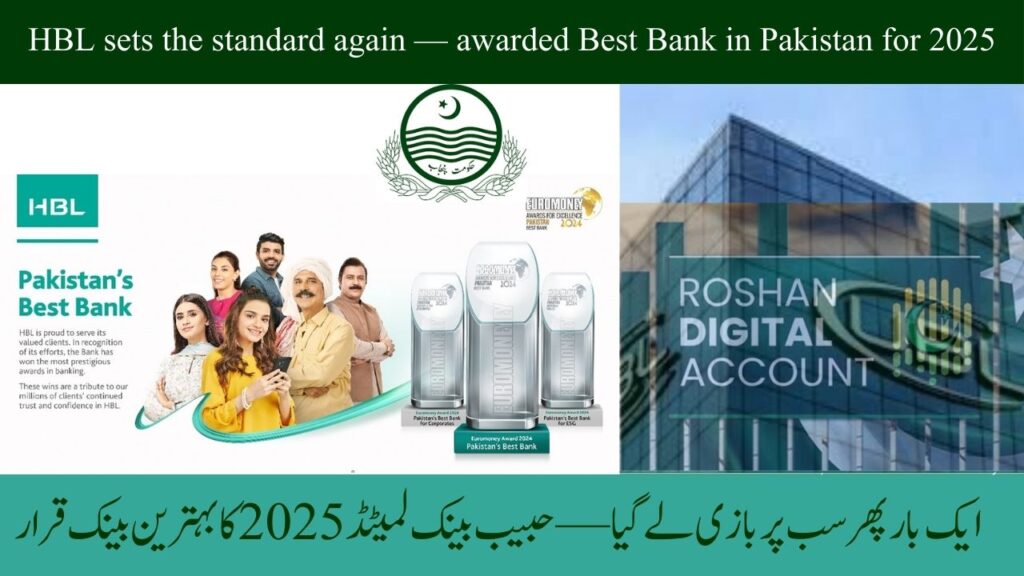Habib Bank Limited (HBL) has been recognized as the Best Bank in Pakistan for 2025 by the International Banking Excellence Awards, marking the second consecutive year the institution has received this prestigious recognition. The award acknowledges HBL’s continued innovation in digital banking, financial inclusion initiatives, and robust performance metrics despite challenging economic conditions.
Best Bank in Pakistan For 2025 Performance Metrics
HBL demonstrated impressive financial results in the fiscal year ending December 2024, reporting a 17.3% increase in net profit compared to the previous year. The bank’s total assets grew to PKR 5.2 trillion (approximately USD 18.6 billion), maintaining its position as Pakistan’s largest private banking institution.
“Financial stability remains our cornerstone, but our growth is increasingly driven by technological innovation and customer-focused solutions,” said Aurangzeb Khan, President and CEO of HBL, during the award ceremony in Dubai last month. “The Pakistani banking sector faces unique challenges, but these also present opportunities for institutions willing to adapt.”
Also Read: Punjab Green Revolution: Solar E-Charging, E-Taxis, and Bullet Train Plans
Digital Banking Leadership
The bank’s digital transformation strategy has been particularly noted by industry analysts. HBL’s mobile banking application now serves over 7.5 million active users, processing more than 85 million transactions monthly—a 32% increase from 2023 figures.
Dr. Amina Rahman, Banking Sector Analyst at Pakistan Economic Research Institute, observed: “HBL’s investment in their digital infrastructure has paid remarkable dividends, not just in customer acquisition but in transaction efficiency and reduced operational costs. Their integration of artificial intelligence for customer service has set new standards in the Pakistani banking sector.”
Financial Inclusion Initiatives
A significant factor in HBL’s recognition was its expansion of banking services to previously underserved populations. The bank’s “Banking Beyond Boundaries” program has established 350 microfinance centers in rural areas across Pakistan, providing basic banking services to over 1.2 million new customers in 2024 alone.
“Access to formal banking remains a critical development challenge in Pakistan,” explained Farooq Siddiqui, HBL’s Director of Rural Banking. “Our microfinance initiatives are designed not just to extend services but to build financial literacy and enable economic participation.”
Competition and Market Position
While HBL claimed the top position, other institutions showed significant strengths. MCB Bank Limited and Bank Alfalah were runners-up in the evaluation, with particularly strong showings in corporate banking and customer satisfaction metrics respectively.
The State Bank of Pakistan’s 2024 Banking Industry Review noted that HBL maintained the largest market share at 14.2% of total banking assets, followed by National Bank of Pakistan (12.7%) and MCB Bank (11.3%).
Challenges and Future Outlook
Despite the accolades, HBL faces ongoing challenges common to Pakistan’s banking sector, including economic uncertainty, regulatory compliance costs, and cybersecurity threats.
“The recognition is welcome, but we remain focused on addressing the fundamental challenges,” stated Saira Iqbal, HBL’s Chief Risk Officer. “Interest rate volatility and currency fluctuations require constant vigilance, while the evolving regulatory landscape demands continuous adaptation.”
Industry observers anticipate increased competition in digital banking services throughout 2025, with several institutions launching enhanced mobile platforms and blockchain-based services in the coming months.
Customer Satisfaction
Independent surveys conducted by Banking Monitor Pakistan placed HBL first in overall customer satisfaction among Pakistan’s major banks, with particularly strong ratings in digital service reliability and customer problem resolution.
“The difference we’ve observed is in how seamlessly HBL integrates traditional banking strengths with modern convenience,” noted Hassan Malik, Banking Monitor Pakistan’s research director. “Their branches maintain the personal touch that many customers still value, while their digital services offer the convenience younger demographics demand.”
Community Impact
HBL’s corporate social responsibility initiatives were also highlighted in the award citation. The bank allocated PKR 1.2 billion (approximately USD 4.3 million) to education, healthcare, and environmental sustainability projects in 2024.
The HBL Foundation’s “Digital Literacy for All” program provided basic computing and online banking education to over 25,000 individuals from low-income communities, with a particular focus on women and elderly citizens.
As Pakistan’s banking sector continues to evolve, HBL’s balanced approach to traditional banking strengths and technological innovation appears to have established a successful model that other institutions are increasingly emulating.
Frequently Asked Questions
What criteria determined HBL’s selection as Best Bank in Pakistan 2025?
The evaluation considered financial performance, digital innovation, customer satisfaction metrics, and financial inclusion initiatives. HBL’s 17.3% profit growth and expansion of digital services to 7.5 million users were particularly significant factors.
How does HBL compare to other major banks in Pakistan?
HBL holds 14.2% of total banking assets in Pakistan, maintaining the largest market share ahead of National Bank of Pakistan and MCB Bank. Independent surveys also ranked HBL first in overall customer satisfaction among major Pakistani banks.
What digital banking innovations has HBL implemented?
HBL’s mobile banking application processes over 85 million transactions monthly, representing a 32% increase from 2023. The bank has also integrated artificial intelligence for customer service and introduced blockchain-based services.
How is HBL addressing financial inclusion in Pakistan?
The bank’s “Banking Beyond Boundaries” program established 350 microfinance centers in rural areas, bringing basic banking services to 1.2 million new customers in 2024. HBL also operates the “Digital Literacy for All” program focusing on underserved populations.
What challenges does HBL face despite its market leadership?
HBL confronts economic uncertainty, interest rate volatility, currency fluctuations, and increasing regulatory compliance costs. Cybersecurity threats and intensifying competition in digital banking services also present ongoing challenges.
